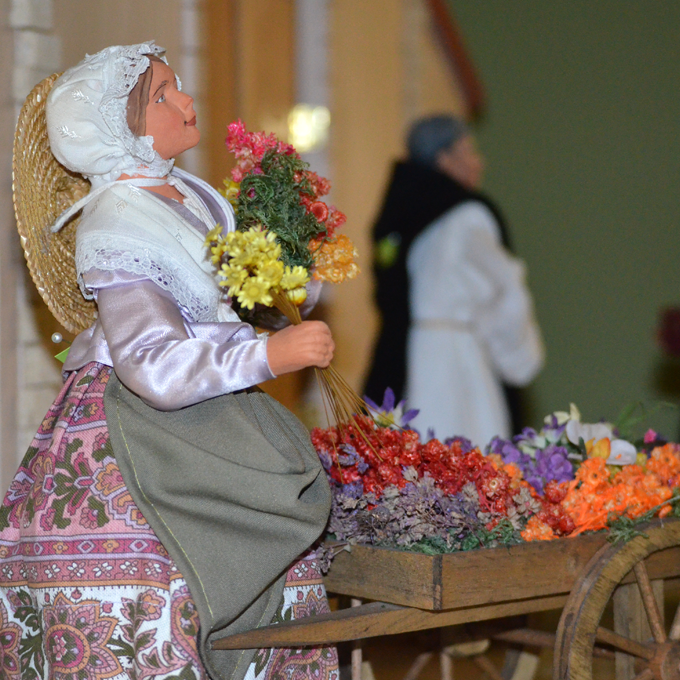France
This large village scene captures the daily lives of the people of a French Provençal village. In this village, all the people of the village will eventually gather at the Manger.
France
The following Nativities are each displayed in a unique permanent setting created by Marian Library Crèche Collection volunteers. The descriptive text for each was written by Father Johann Roten, S.M.
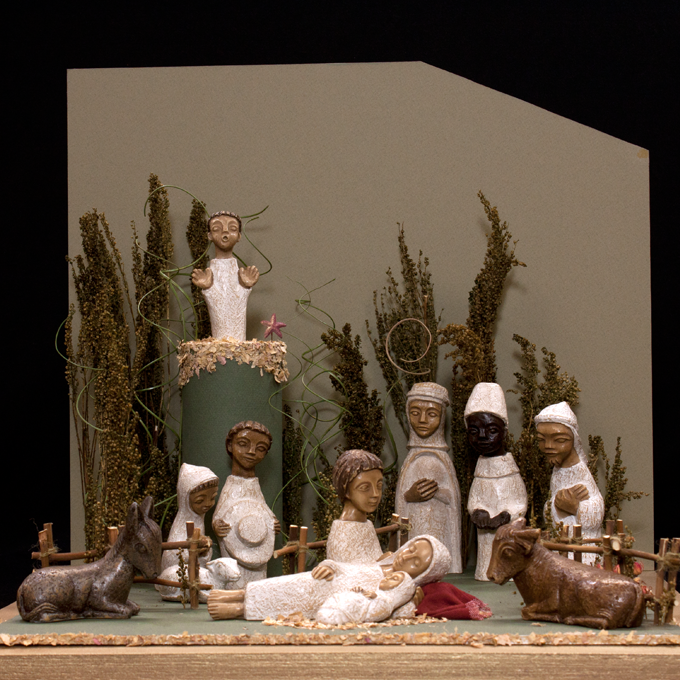
Romanesque Realism
Sisters of Bethlehem
Artistic revivalism has been with us for ever. We find it in the periodical rediscovery of sacred icons, the rehabilitation of antiquity during the Renaissance, the retrieval of medieval forms and features in pre-Raphaelite art, etc. This nativity set illustrates contemporary interest in the simple and earth-bound beauty of Romanesque art. The Sisters of Bethlehem, who crafted this set, took their inspiration from stone-hewn figures and scenes on portals and capitals of Medieval French cathedrals such as Autun and Amiens.
The sober and straight lines of the overall design lend the characters a dignified immobility. It is contrasted with their big hands and eyes that speak a different language. Although mostly folded in peaceful contemplation of the Christ child, the heavy hands suggest a longstanding and active familiarity with the concrete realities of this world. They are delightfully offset by the rounded eyes filled with wonder and kindness. The figure of Mary is a telling example of Romanesque realism. Not yet kneeling in adoration as in subsequent periods, but exhausted and reclining, she gives the child the shelter of her body, and holds his head in a gesture of maternal affection.
– ML.0105.05
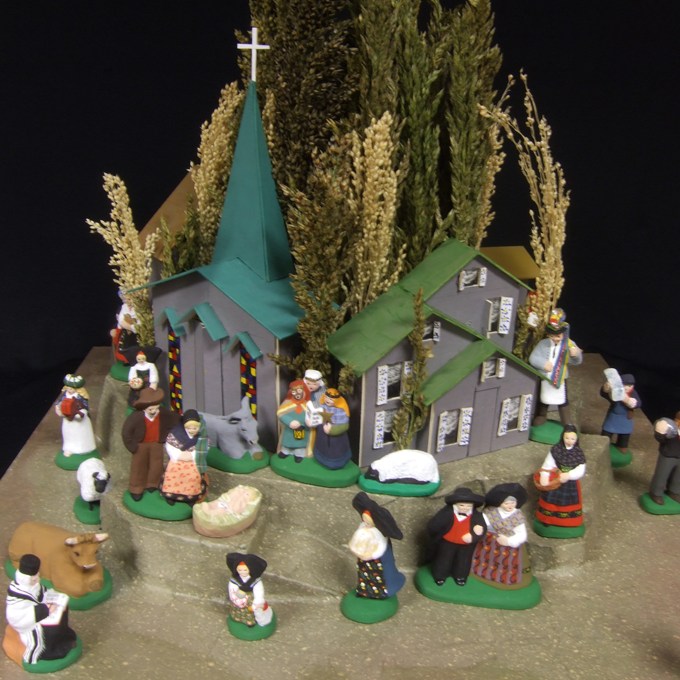
The Best of Two Worlds
Pascale Delorme
Alsatia
Where the best of two worlds combine there is Alsatia, a narrow strip of land in eastern France bordering Germany. Its culture is a happy combination of the typical French "joy of life" and the solid, hard-working and efficient character of Germany. This nativity of Alsatian santons is set in a landscape of rolling green hills, beds of blooming flowers, and wispy clouds sailing in the sky. Like in Provençal tradition, the burnt clay figurines reflect various activities and typical local costumes exquisitely painted. There is the lady with the cabbage cart (sauerkraut), the man carrying a block of ice, the girl taking a Gugelhopf (typical Alsatian pastry) to the manger, and the proud Strassbourg lady all dressed up in her Sunday best. The Holy Family almost disappears among the thirty-two personages. The holy couple in local costumes looks much like the ordinary couple they once appeared to be. But they hold each other, and the holy Child rests peacefully in their loving presence. Next to the Holy Family sits the rabbi pondering the scriptures, trying to make sense of this incongruous event.
– ML.0078.15
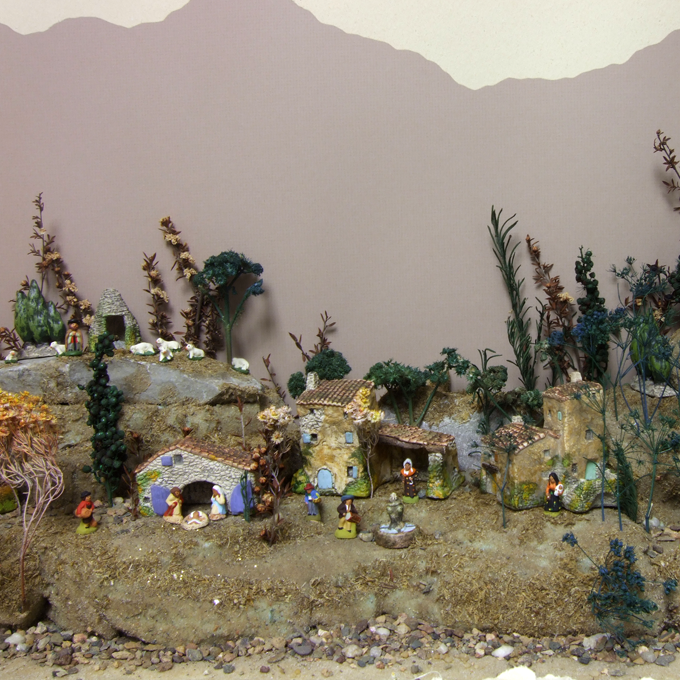
To the Little and Simple Ones...
Marcel Carbonel
Provence
The typical Provençal village is seen here from the sea. But this is a miniature edition. There exists in some countries a tradition to craft miniature crèches. Famous are the matchbox crèches of Peru and Saxony (Erzgebirge). There is one figure among these little people which begs for special attention. His name is "Le Ravi," and he usually stands in a remote area of the nativity scene. Both hands and arms are raised to heaven to express ravissement, meaning rapture. A farm hand, the boy is somewhat naive and simple-minded. But he is the only one in the whole village to manifest openly his guileless happiness on hearing the news of Jesus' birth. This moving character made its appearance at the beginning of the nineteenth century in Marseilles.
– ML.0147.16
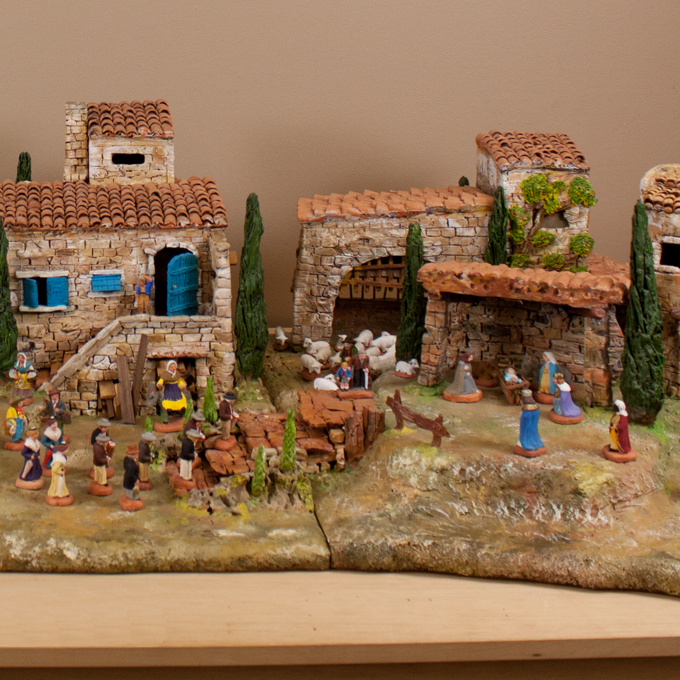
The Global Village
Gustave Schneider
Provence
This crèche, built for The Marian Library Collection, represents one of the most important European crèche traditions, that of the lower Rhone Valley in southeastern France called Provence, with cities like Marseille, Arles, Aix-en-Provence and Avignon.Faithful to the local tradition, Schneider (originally from Switzerland) built a village with many ingredients of Provençal life: the tiled roofs, the Provençal blue of the shutters, the little vineyard in front of the house, and the round tower, home for the many pigeons in the region. This is only the setting for the many people living in the village, each character with his or her name and special role. Various professions are represented as are old age and youth, and in this set is the band on its way to the crèche, led by the mayor with his red umbrella. In Provençal tradition each of these figures has a role to play in the sacred drama. Each has its life story which will come to a climax in front of the Christ child. The Provençal village is a symbol of the world, the global village. Its history, in Christian tradition, is lived with Christ at its center. We either move toward or away from him, as do the characters in the Provençal crèche. In the end, they will all be gathered around the divine Child.
– ML.1119.14
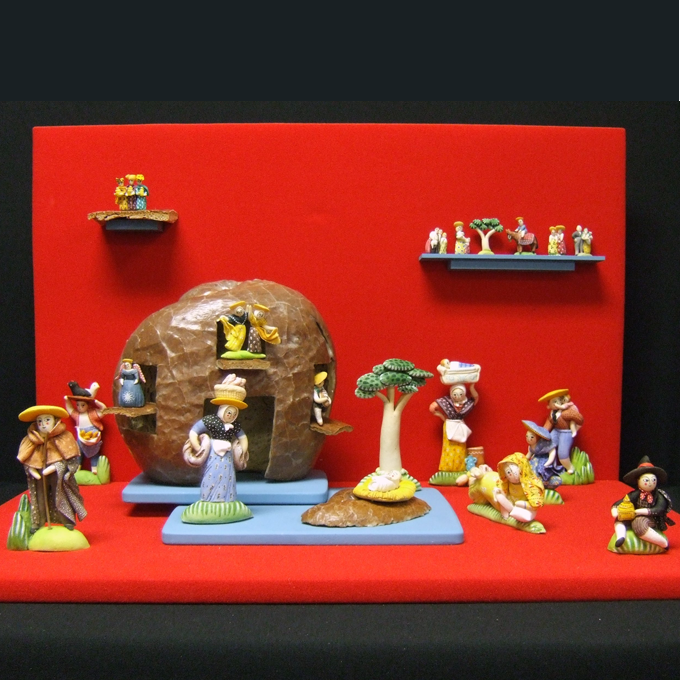
House of Bread
Catherine Baillaud
This nativity set presents us with a real house of bread, reminiscent of the meaning of the word Bethlehem. Christ was born in a House of Bread (Bethlehem), and eventually offered himself as the Bread of Life to those who hunger for justice and peace. Catherine Baillaud is an accomplished bread dough artist, and a master of delicate and inspired coloring.
– ML.0115.03
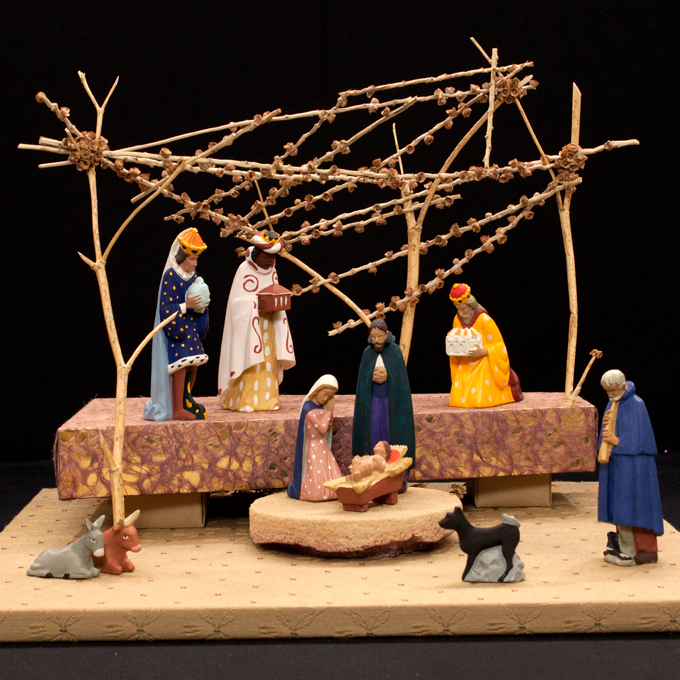
Elegant Piety
Fernand Py
Puzzled by the prosaic and ordinary simplicity of the first Christmas, adult generosity seeks to improve the original with added elegance and riches. Fernand Py's figures have the noble profile of Gothic art enriched with a touch of ornamental magic. In elevated station like the kings, or huddled around the manger, the actors of this scene are a tribute to elegant piety.
– ML.0139.23
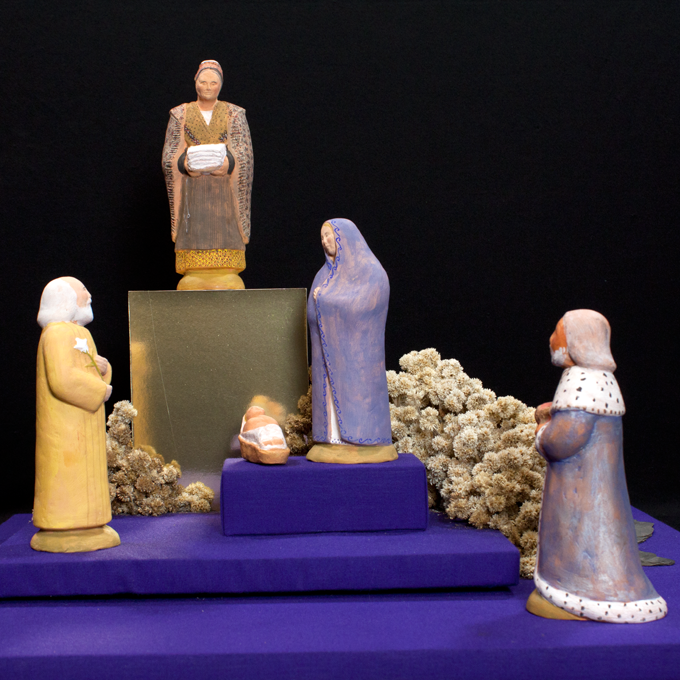
In Praise of Life
Evelyne Ricord
The imposing woman on the pedestal is a midwife carrying scissors and holding diapers. Evelyne Ricord, whose art is marked by the Provencal tradition, has created this richly and delicately ornamented figure in praise of life and those who facilitate life. Whatever the role of the (apocryphal) midwife in Christ's birth, this midwife stands for all those who contribute and facilitate the birth of Christ in the hearts of all people.
– ML.0078.26
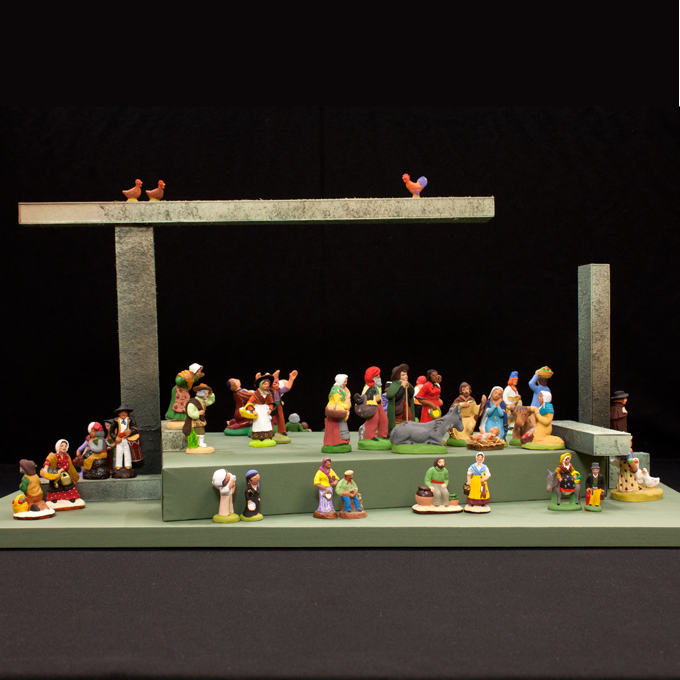
French Santons
Various Studios
There are santons from Alsatia and Brittany. They are recent creations. The classical santons are from Provence in southern France. They are the “real” santons, the French santons. There are many and famous studios specializing in the creation of santons. In this nativity set, we have gathered forty-two santons, representing sixteen different studios, most of which are located in the southern region of Provence. The nativity group surrounded be five other characters, among them a shepherd and the gypsy woman with her baby, was created by the Coulomb studio. Most of the other “maisons” (studios) are represented with two figures. Name and history of the little characters remain unchanged, no matter which studio they come from. The difference lies in the coloring, in the details of the overall facial expressions, sometimes in the presentation of the attributes that define each character.
– ML.1118.17
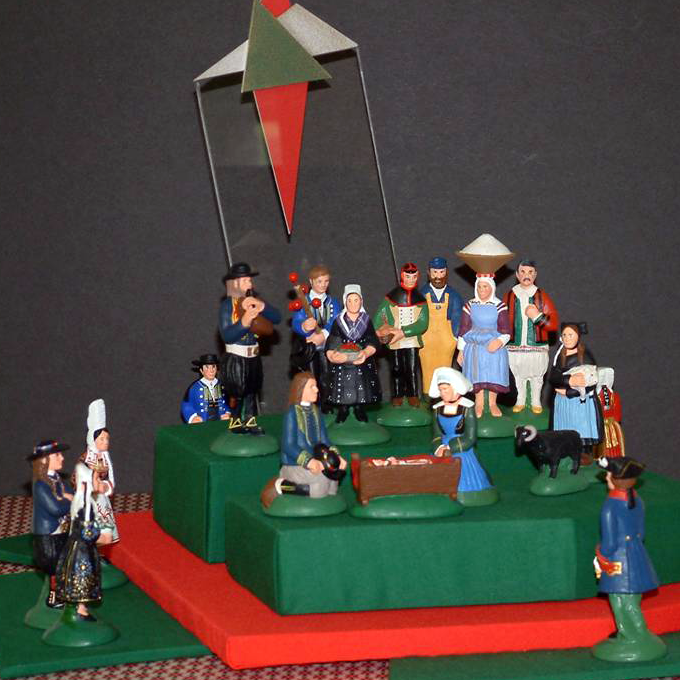
Santons of Brittany
Studio “Roi de Bretagne”
Ferociously independent and intensely dedicated to the sea, Saint Anne, and its reputation of being the guardian of the end of the world (Finistère), Brittany, situated in the northwestern corner of France, has its own brand of Santons. Manufactured by the studio of “Roi de Bretagne” in Plougastel, the figures are entirely handcrafted and painted. Each piece bears the initials of the artisan who made it. The costumes are based on models exhibited in the “Musé e departemental Breton” of Quimper. Jesus is featured in the baptismal attire of Plougastel, whereas Mary and Joseph are wearing the costumes of Point-Aven respectively, Bannalec. The couple of Guérande, called “swampers,” are collectors of salt. Johnny of Roscoff is selling onions in England. He is accompanied by his buddy, the fisherman, who takes him across the channel. The ladies of Morbihan represent human condition: they are the “chatter boxes.” The couple of Plougastel carries an apple tree laden with red apples – a promise of new life in the midst of winter, and a symbol of Christmas.
– ML.1118.16
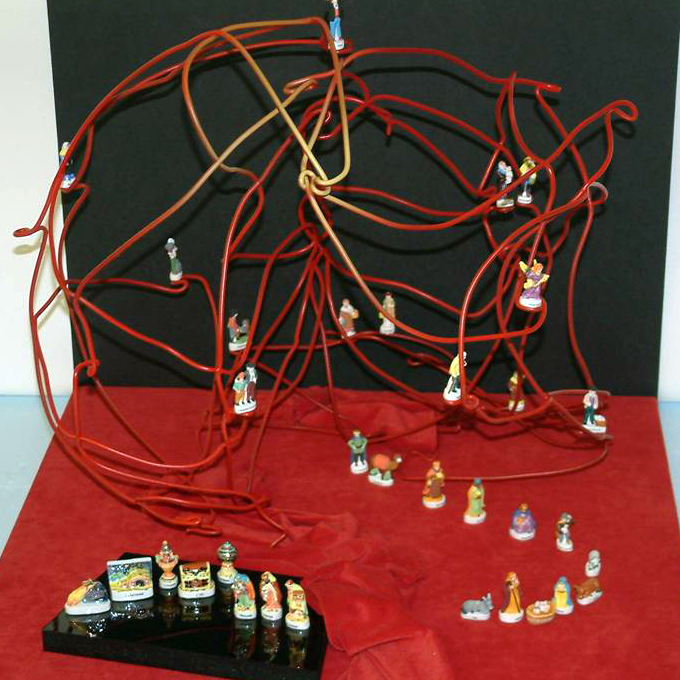
King or Queen for a Day
Unknown
There are twenty-five tiny Santons in this nativity. The Porcelain figures are identified, in French, as some of the typical characters of Provençal Christmas lore: the miller, the blind man and his young guide, the knife grinder, and the village fool in rapture – to name only some of them. Their role in this set is not to be representatives of their village at the manger, but to be put as “premiums” in the Epiphany cake! Following an old European tradition, beans were hidden in the cakes (galettes des rois) gracing the dinner table on January 6, feast of the Three Kings. The lucky guest or member of the family who found a bean in his cake was made king or queen of the day. Over time, the beans were replaced with little figurines, especially kings, but also other Santons. Who, child or adult, would not want to be king or queen for a day?
– ML.1118.20
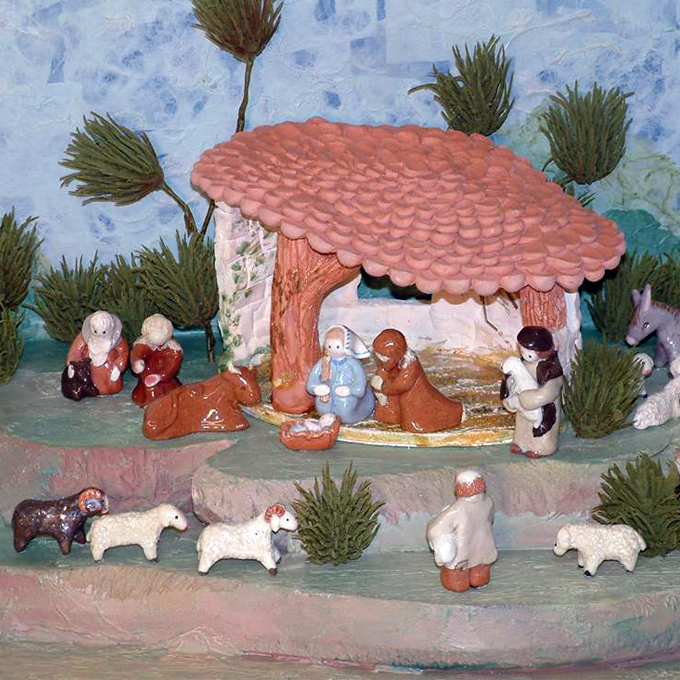
The Stuff of Fairy Tales
Agnès Boiste
This rounded abode with its coquettish roof seems to be breathing with life from Mother Earth. Some will see in this stable a giant mushroom home of fairies and dwarfs. The charming little characters are like jewels spilling from a treasure trough. Agnès Boiste’s ceramic figures are Santons in their own right. They don’t make a sociological or cultural statement, but they are the stuff of children’s dreams and fairy tales. There is a part of Christmas which can only be captured in fairy tales and dreams.
– ML.1118.13
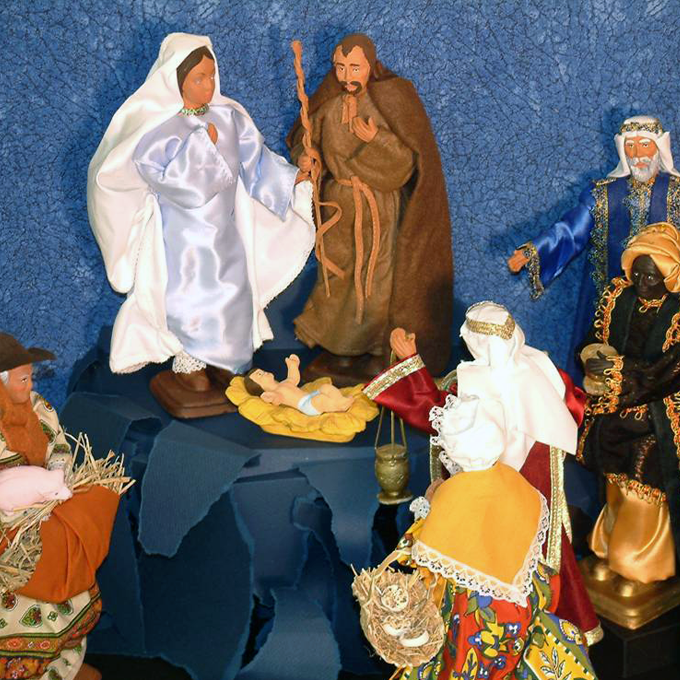
Aristocrats Among Santons
Yolande
Aristocrats among the Santons of Provence, these figures hide their humble clay origin in sumptuous costumes. Dressed in the elegant and colorful robes of townspeople, or donned with the comfortably dark clothes of shepherds and farmers, Yolande’s Santons reflect the bright colors of sun and sea, and the scorched earth of the northern regions of Provence.
– ML.0161.21,22
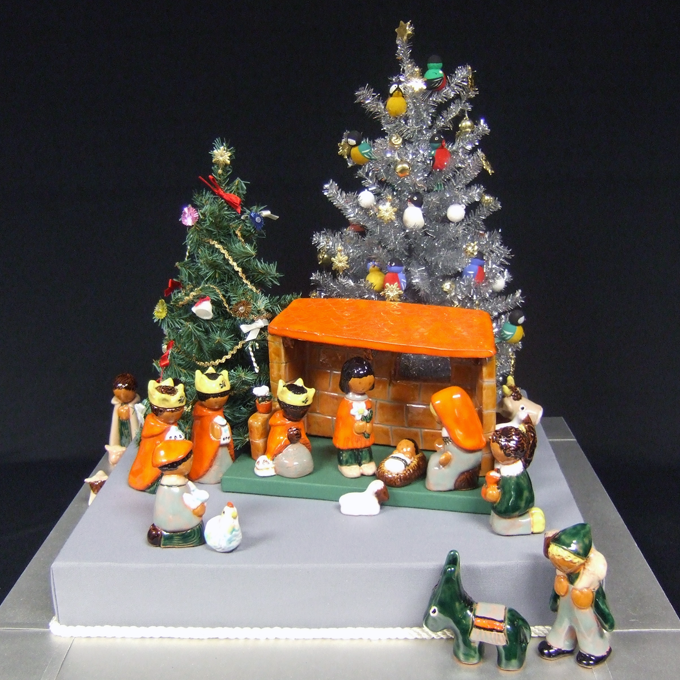
Color Orange
Benedictines of Jouarre
Orange, the dominant color in this nativity set, is a combination of red and yellow. It is vibrant and suggests warmth and energy. Where red may be aggressive, orange radiates cheerfulness; where yellow suggests brilliance the color orange gives fullness and depth to the light. A color on the edge, orange reconciles the heat of summer with the cool of winter. And orange stimulates emotion. According to some it even generates appetite. The shining santons of the Sisters of Jouarre, a Merovingian foundation in the Ile-de-France region, are cheerful messengers. True to their monastic origin, they bring a roly-poly homage to the manger. They are taking the santon tradition to a new level. Gone are the checkered villagers à la Carbonel, and in march the “little saints” of orange culture: a culture of cheerful depth and childlike plenitude, the promise of a culture of reconciliation and spiritual appetite.
– ML.0078.09
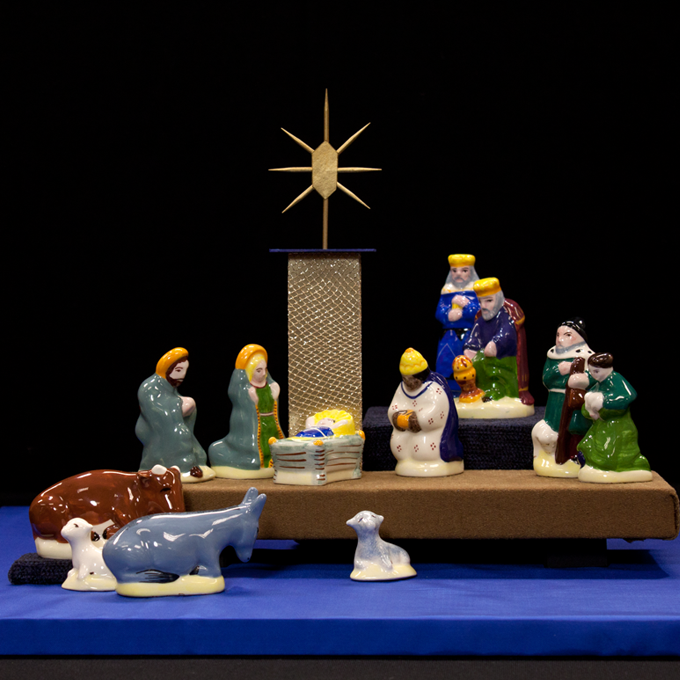
The Quimper Saints
H.B. Henriot
In France nativity figures go by the name of santons after the famous santons of Provence. Thus, are well known the santons of Alsace (P. Delorme) and the santons of Brittany (Roi de Bretagne). A popular name for small and cheap statues of saints in the beginning (1850-1900), these "little saints" or santons are the guardians of at least one small corner of the French soul: its charming, gregarious, and joyful nature. In Quimper (Brittany), one of the citadels of French faience creations, they achieve a special patrician look thanks to their intense colored glazes: the white, yellow, and blue colors of the magi, and the greens for the shepherds. Only Mary and Joseph, no doubt to single out their humble station, are clad in colors of grayish green. The Christ Child sides with the kingly visitors in regal blue, white, and yellow.
– ML.0107.02
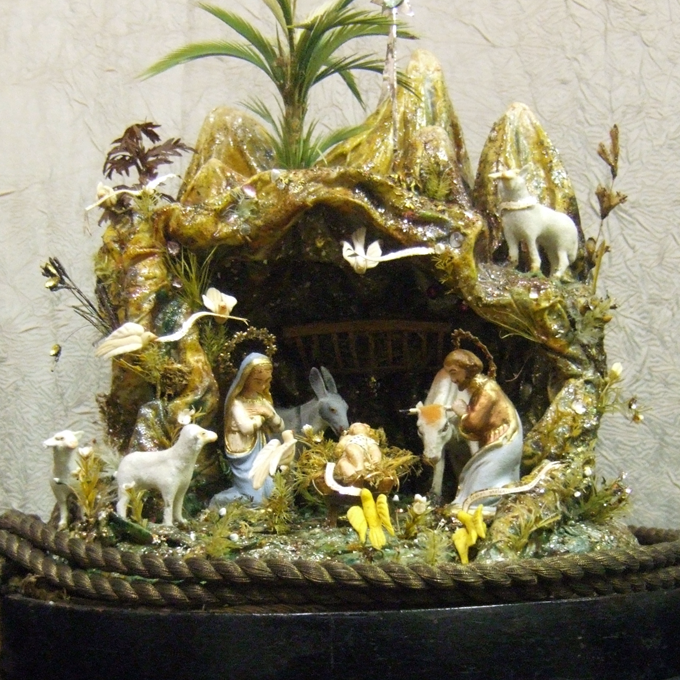
A Feminine Touch
Monastic Nuns
Monasteries have been for centuries a source of inspiration and support of the nativity tradition. The custom of “Rocking the Baby,” Christmas carols such as “In Dulce Jubilo,” and crèches of all forms and sizes had their origin in monasteries of nuns. Even now, monasteries of women enrich the crèche tradition with artful and original creations. The very delicate artifact or display here stems from this century-old custom. Created in the late 1800s, it has a very definite feminine touch. Flowers and stars, little birds holding phylacteries with calligraphed prayers, tender lambs and enraptured parents hail the newborn king in his star-strewn shirt. The nativity grotto is carved into a mountain of papier-mâché. Its peaks and crevasses are sprinkled with glint and glitter glistening in colors of blue and gold. On the back of the crèche mountain, a yellow snake rears his head. Although entering into the darkest recesses of the human heart, and plunging it into the golden shimmer of his love, the Christ Child is not yet the sole master of this world. For now, the menacing head of the snake is never far.
– ML.2651
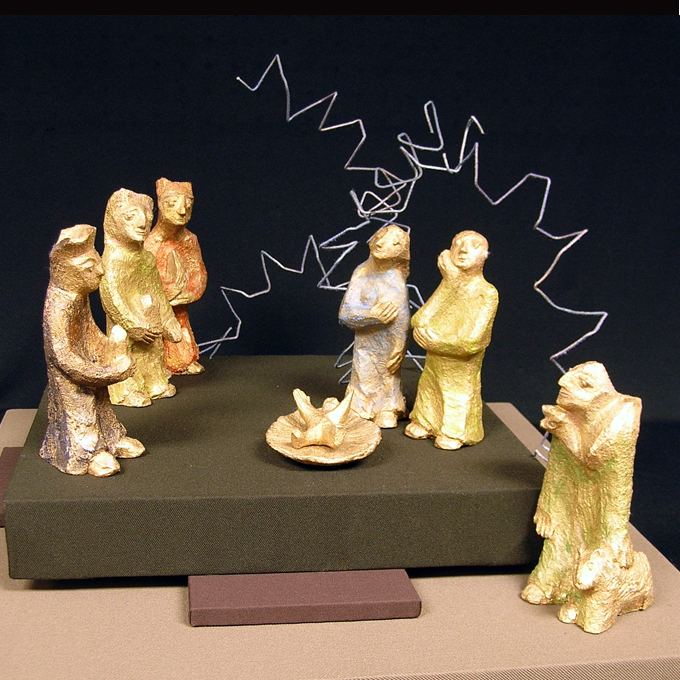
The Stuff of Life
Pascale Bulloz
Christmas closely relates to expectation and future and new life. Pascale Bulloz’s figures are a tribute to new life; of form and character emerging from formless matter. Coated with gold patina they are a timely reminder of how noble and precious the “stuff of life” is.
– ML.3487
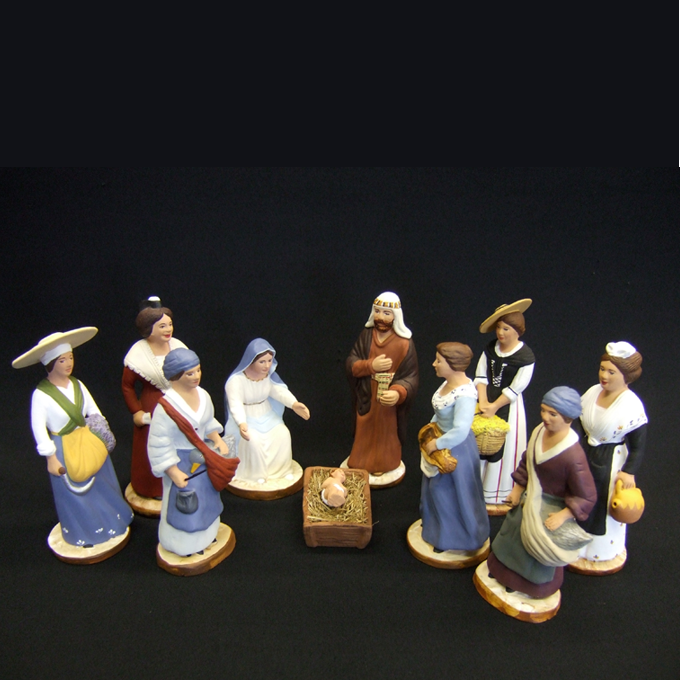
A Woman's Nativity
Arterra
Why are nativity sets peopled with a majority of men? Is there no room for women? This Provençal set is a crèche for women only—or almost. Led by Ravido, the woman in rapture, here they come: bourgeoises with their broad-rimmed hats, but mostly peasant women carrying lavender and fish, fruit, and the holiday goose.
– ML.2160
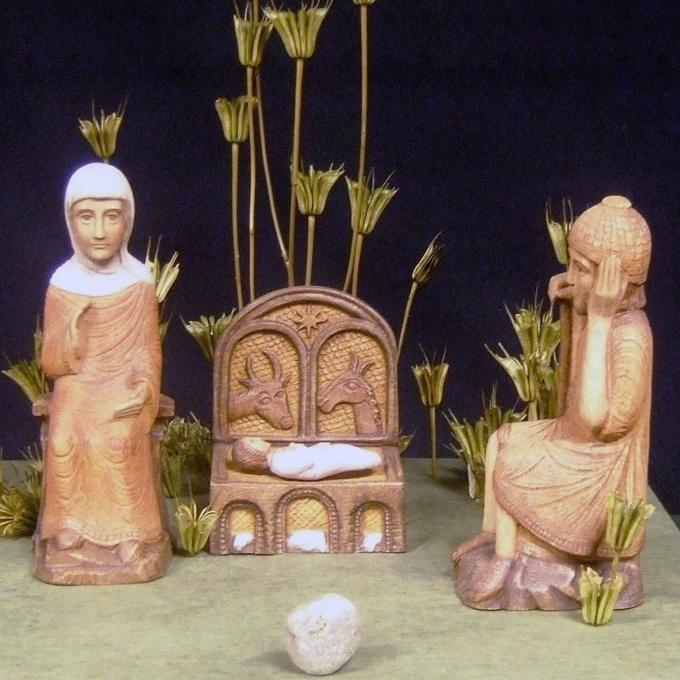
Peaceful Interiority
Bethlehem Sisters
Bombastic and superficial, some of contemporary Christmas culture irks and annoys adult taste. A possible reaction is illustrated in this Romanesque nativity. Retrieving the art of medieval bas-reliefs and sculpted capitals, the Sisters of Bethlehem offer a Christmas world of peaceful interiority and serene contemplation.
– ML.2161
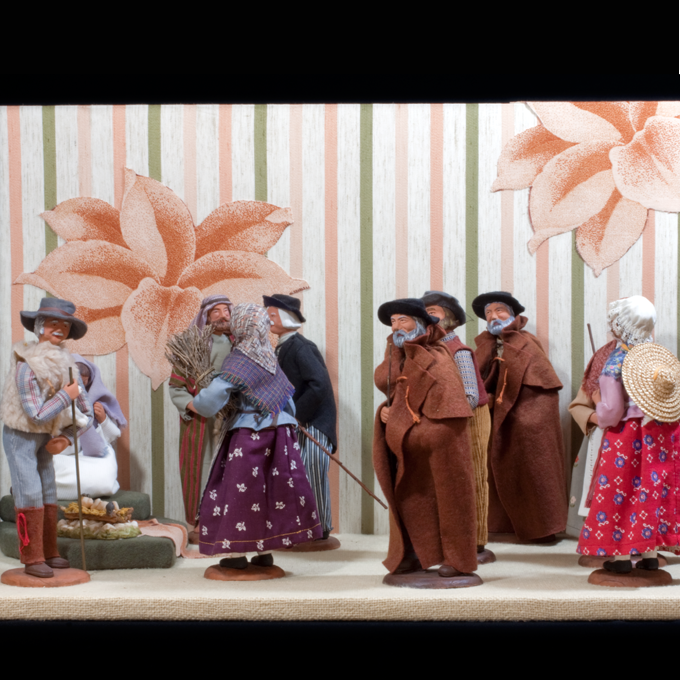
Christ in the Village
J. Peyron
Aubgane
In the French tradition of Provence the Holy Family comes to the village, and then only will the people gather around the manger. Provençal Santons — the so-called "little saints" — are most gregarious. And when Christmas comes, the whole village from the mayor to the village fool is mobilized. Without exception! Even the Gypsy woman with tambourine and brightly colored clothes is part of the cortege. Now have you ever seen a congregation of Frenchmen and women that does not engage in some lively discussion and dispute? And so this nativity scene could have been called "The Dispute." From the running commentary by the farmer on the left looking at you — to the two ladies engrossed in conversation on the right side, the whole scene is bristling with a mixture of curiosity and enthusiasm. Not even Joseph escapes the quizzing of Professor Boniface. Meanwhile, Mary holds silent watch, and the "Bousquae-tiero, " the woman with the bundle of wood, delivers her modest gift.
[Elisabeth van Mullekom Collection]
– MLA.386
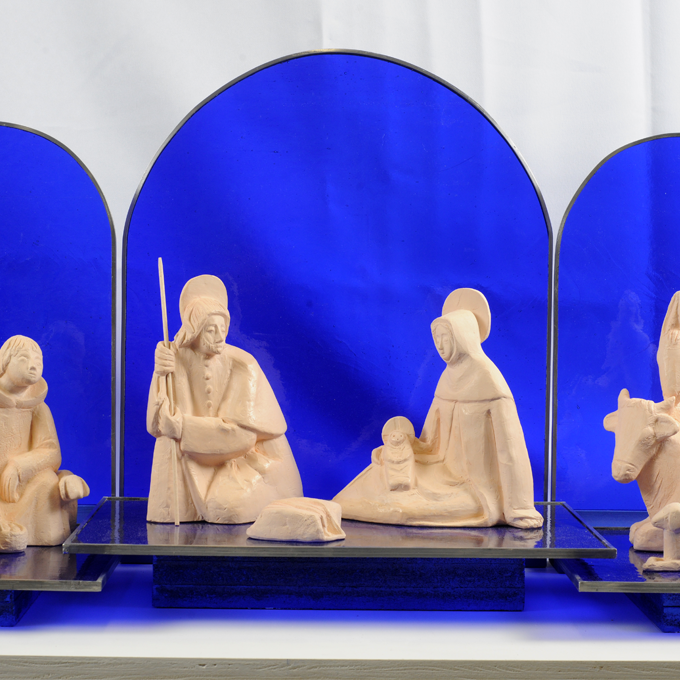
Guardians of the Savior
Marie Arbel
This nativity set was created by Marie Arbel, a French liturgical artist. It bears the marks of the mid-twentieth century reawakening of sacred art. The simple lines and classical forms of the figures reflect a downright departure from the sentimental art of St. Sulpice. They signal at the same time a new spiritual realism and openness to the stylistic canons of contemporary art. The calm stability of the various characters, ox and ass in particular, amply justify the title of "Guardians of the Savior."
– ML.4676
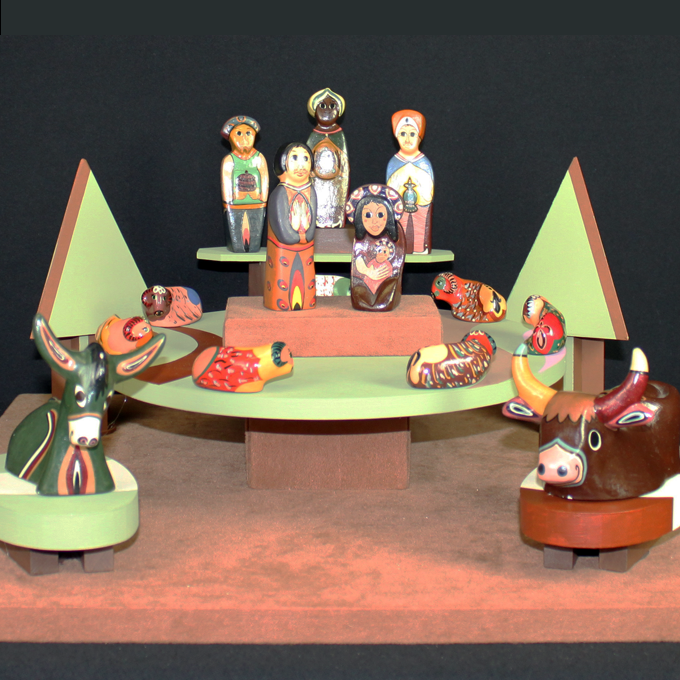
Painted Messages
France Arac
As to shape and form these figurines, people and animals, are of utter simplicity, but the true message lies in their painted faces and bodies. There is a playful beauty and childlike joy in the art-déco style coloring of this nativity set which makes it precious in the eyes of the adult and thoroughly engaging to children.
– ML.0078.16

